Fabrication and Characterization of Three-Dimensional Microelectromechanical System Coaxial Socket Device for Semiconductor Package Testing
Abstract
1. Introduction
2. Proposed 3D MEMS Coaxial Socket
2.1. Design of 3D Coaxial Socket
2.2. Impedance Matching of the 3D MEMS Coaxial Socket
2.3. Fabrication of the 3D MEMS Coaxial Socket
3. Mechanical Charactersitics
3.1. Behaviour of 3D MEMS Structure
3.2. Three-Dimensional MEMS Structure Force and Contact Resistance
4. Electrical Characteristics
Thermal Shock Test
5. Conclusions
6. Patents
Author Contributions
Funding
Institutional Review Board Statement
Informed Consent Statement
Data Availability Statement
Acknowledgments
Conflicts of Interest
References
- Liang, C.L.; Lin, Y.S.; Kao, C.L.; Tarng, D.; Wang, S.B.; Hung, Y.C.; Lin, K.L. Electromigration Failure Study of a Fine-pitch 2 µm/2 µm L/S Cu Redistribution Line Embedded in Polyimide for Advanced High-density Fan-out Packaging. In Proceedings of the 2020 IEEE 70th Electronic Components and Technology Conference (ECTC), Orlando, FL, USA, 3–30 June 2020; pp. 361–366. [Google Scholar] [CrossRef]
- Dwarakanath, S.; Raj, P.M.; Agarwal, A.; Okamoto, D.; Kubo, A.; Liu, F.; Kathaperumal, M.; Tummala, R.R. Evaluation of Fine-Pitch Routing Capabilities of Advanced Dielectric Materials for High Speed Panel-RDL in 2.5D Interposer and Fan-Out Packages. In Proceedings of the 2019 IEEE 69th Electronic Components and Technology Conference (ECTC), Las Vegas, NV, USA, 28–31 May 2019; pp. 718–725. [Google Scholar] [CrossRef]
- Liang, C.L.; Lin, Y.S.; Kao, C.L.; Tarng, D.; Wang, S.B.; Hung, Y.C.; Lin, G.T.; Lin, K.L. Electromigration Reliability of Advanced High-Density Fan-Out Packaging With Fine-Pitch 2-/2-μm L/S Cu Redistribution Lines. IEEE Trans. Compon. Packag. Manuf. Technol. 2020, 10, 1438–1445. [Google Scholar] [CrossRef]
- Lee, H.H.S.; Chakrabarty, K. Test Challenges for 3D Integrated Circuits. IEEE Des. Test Comput. 2009, 26, 26–35. [Google Scholar] [CrossRef]
- Tunaboylu, B. Electrical Characterization of Test Sockets With Novel Contactors. IEEE Trans. Device Mater. Reliab. 2014, 14, 580–582. [Google Scholar] [CrossRef]
- Amin, N.; Yi, L.Z. A practical investigation on the root causes of the mechanical damages of pogo pin type test sockets to IC packages in final test. In Proceedings of the 2008 IEEE International Conference on Semiconductor Electronics, Johar Bahru, Malaysia, 25–27 November 2008; pp. 393–397. [Google Scholar] [CrossRef]
- Lee, K.M.; Oh, J.H.; Kim, M.S.; Kim, T.S.; Kim, M. RF Pogo-Pin Probe Card Design Aimed at Automated Millimeter-Wave Multi-Port Integrated-Circuit Testing. Electronics 2021, 10, 2446. [Google Scholar] [CrossRef]
- Teng, H.C.; Chen, M.K.; Yeh, C.H.; Huang, Y.J.; Fu, S.L. Study of contact degradation in final testing for BGA socket. In Proceedings of the 2007 International Conference on Electronic Materials and Packaging, Daejeon, Republic of Korea, 19–22 November 2007; pp. 1–6. [Google Scholar] [CrossRef]
- Park, J.; Kim, H.; Kim, Y.; Kim, J.J.; Bae, B.; Kim, J.; Ha, D.; Bae, M. Analysis of external force dependent lumped RLGC model of high-bandwidth and high-density silicone rubber socket. In Proceedings of the 2015 IEEE Electrical Design of Advanced Packaging and Systems Symposium (EDAPS), Seoul, Republic of Korea, 14–16 December 2015; pp. 54–57. [Google Scholar] [CrossRef]
- Park, J.; Kim, H.; Kim, J.J.; Kim, D.H.; Son, K.; Kim, S.; Lee, S.; Cho, K.; Bae, B.; Ha, D.; et al. High-Frequency Electrical Characterization of a New Coaxial Silicone Rubber Socket for High-Bandwidth and High-Density Package Test. IEEE Trans. Compon. Packag. Manuf. Technol. 2018, 8, 2152–2162. [Google Scholar] [CrossRef]
- Kim, H.; Kim, J.J.; Park, J.; Park, S.; Choi, S.; Bae, B.; Ha, D.; Bae, M.; Kim, J. High-Frequency Modeling and Signal Integrity Analysis of a Silicone Rubber Socket for High-Performance Package. IEEE Trans. Compon. Packag. Manuf. Technol. 2017, 7, 1356–1368. [Google Scholar] [CrossRef]
- Schelkunoff, S.A. The electromagnetic theory of coaxial transmission lines and cylindrical shields. Bell Syst. Tech. J. 1934, 13, 532–579. [Google Scholar] [CrossRef]
- Cruzan, O.; Garver, R. Characteristic Impedance of Rectangular Coaxial Transmission Lines. IEEE Trans. Microw. Theory Tech. 1964, 12, 488–495. [Google Scholar] [CrossRef]
- Wu, S.M.; Wang, K.Y.; Liu, C.H. Impedance Matching Capability of Novel Socket Contactor Design Using Variable Open Stubfor RF Packaging Testing. Prog. Electromagn. Res. 2011, 113, 67–82. [Google Scholar] [CrossRef]
- Safavi, M.S.; Tanhaei, M.; Ahmadipour, M.F.; Ghaffari Adli, R.; Mahdavi, S.; Walsh, F.C. Electrodeposited Ni-Co alloy-particle composite coatings: A comprehensive review. Surf. Coatings Technol. 2020, 382, 125153. [Google Scholar] [CrossRef]
- Gómez, E.; Pellicer, E.; Vallés, E. Electrodeposition of cobalt based alloys for MEMS applications. Trans. IMF 2005, 83, 248–254. [Google Scholar] [CrossRef]
- Technical Data Sheet, S.S.E. 11-3184-sylgard-184-elastomer. 2017. Available online: http://www.dow.com/content/dam/dcc/documents/en-us/productdatasheet/11/11-31/11-3184-sylgard-184-elastomer.pdf (accessed on 28 May 2023).
- Hopf, R.; Bernardi, L.; Menze, J.; Zündel, M.; Mazza, E.; Ehret, A. Experimental and theoretical analyses of the age-dependent large-strain behavior of Sylgard 184 (10:1) silicone elastomer. J. Mech. Behav. Biomed. Mater. 2016, 60, 425–437. [Google Scholar] [CrossRef] [PubMed]
- Johnston, I.D.; McCluskey, D.K.; Tan, C.K.L.; Tracey, M.C. Mechanical characterization of bulk Sylgard 184 for microfluidics and microengineering. J. Micromech. Microeng. 2014, 24, 035017. [Google Scholar] [CrossRef]
- Zhou, S.; Lin, Z.; Qiu, B.; Wang, H.; Xiong, J.; He, C.; Zhou, B.; Pan, Y.; Huang, R.; Bao, Y.; et al. Evaluation of Solder Joint Reliability in 3D Packaging Memory Devices under Thermal Shock. Electronics 2022, 11, 2556. [Google Scholar] [CrossRef]
- Shutze, M.; Quadakkers, W.J. Novel Approaches to Improving High Temperature Corrosion Resistance; Woodhead Publishing Limited: Sawston, UK, 2008; Volume 24. [Google Scholar] [CrossRef]
- ESPEC. Air to Air Thermal Shock Chambers TSA Series. 2018. Available online: http://www.espec.co.jp/english/products/catalog/tsa.pdf (accessed on 28 May 2023).
- Southwest Microwave. 1.0 mm (W) Jack (FEMALE) 4 Hole .375 Square. 2023. Available online: http://mpd.southwestmicrowave.com/product/2412-01sf-1-0mm-w-jack-female-4-hole-375-square/ (accessed on 28 May 2023).
- Barnes, H.; Bogatin, E.; Moreira, J. Development of a PCB kit for s-parameter de-embedding algorithms verification. In Proceedings of the 2017 IEEE International Symposium on Electromagnetic Compatibility & Signal/Power Integrity (EMCSI), Gaithersburg, MI, USA, 4–12 August 2017; pp. 510–515. [Google Scholar] [CrossRef]
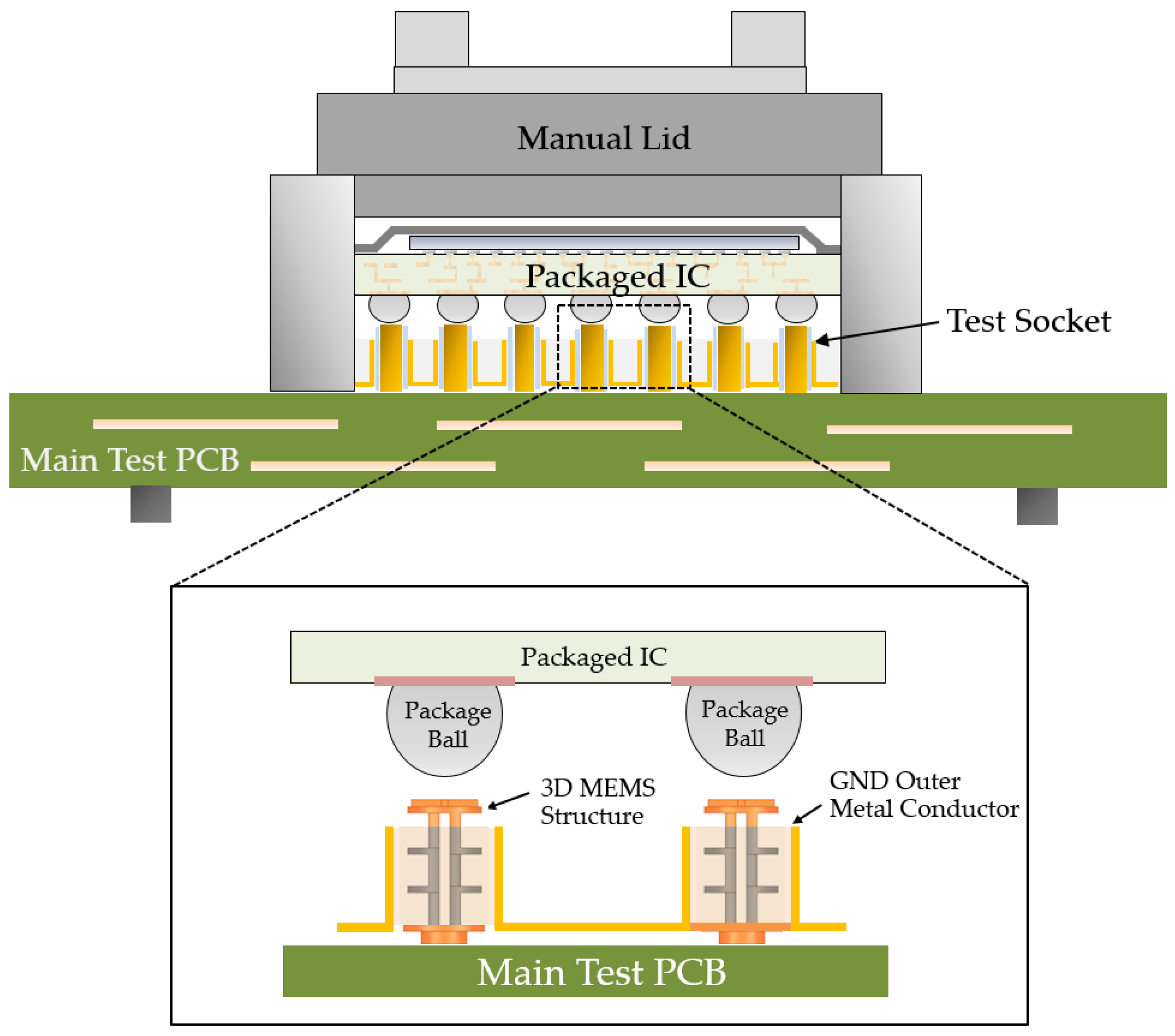
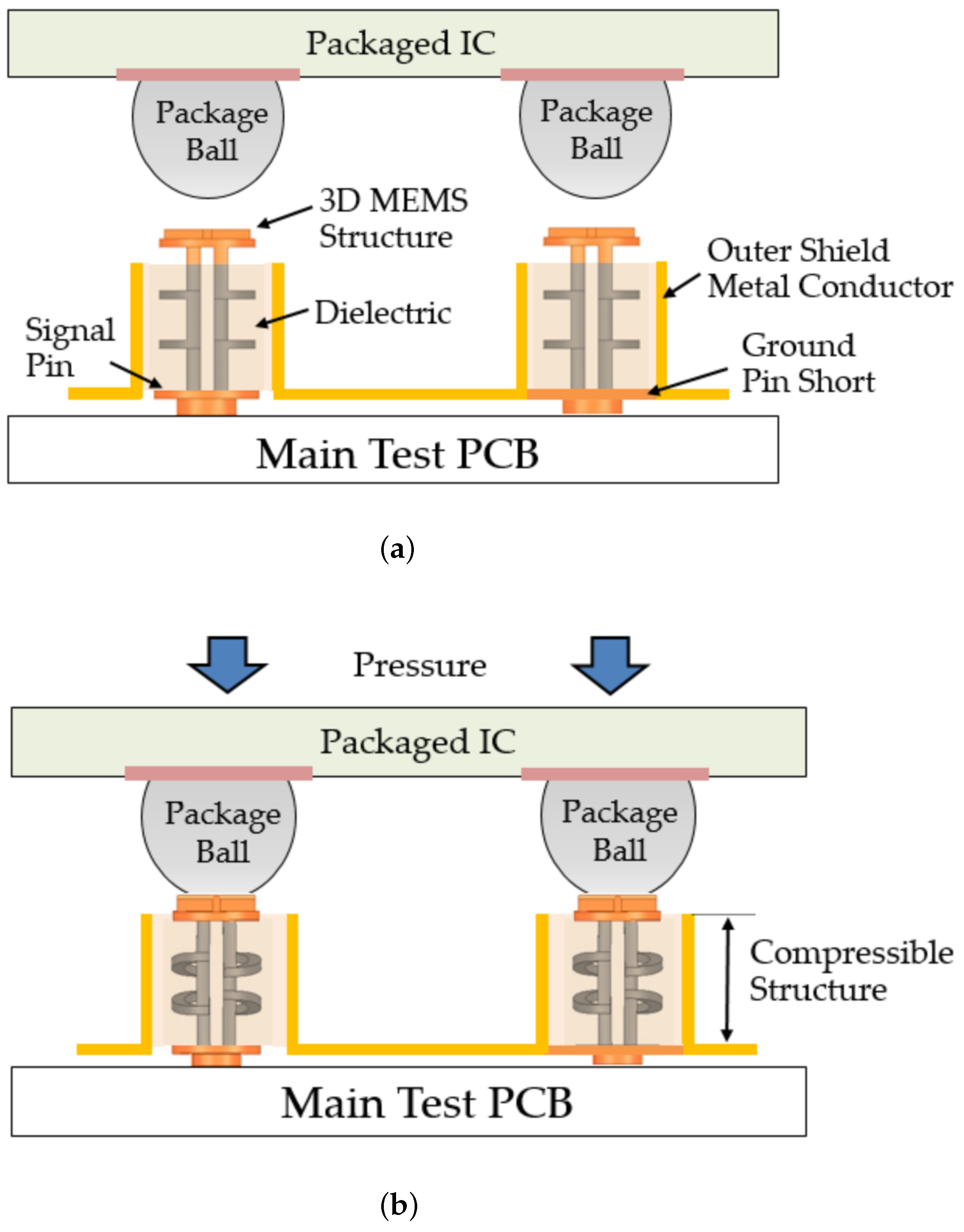

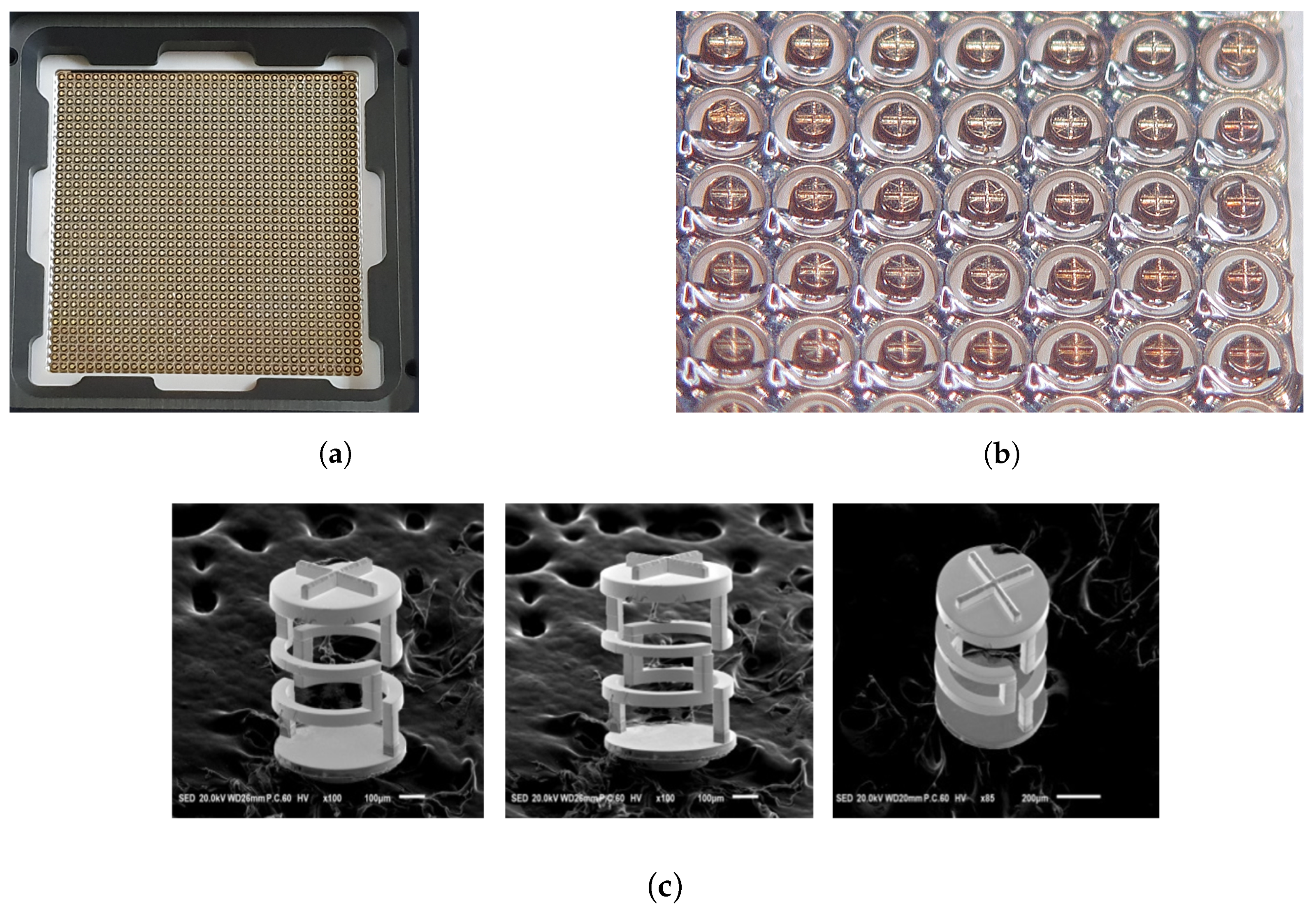
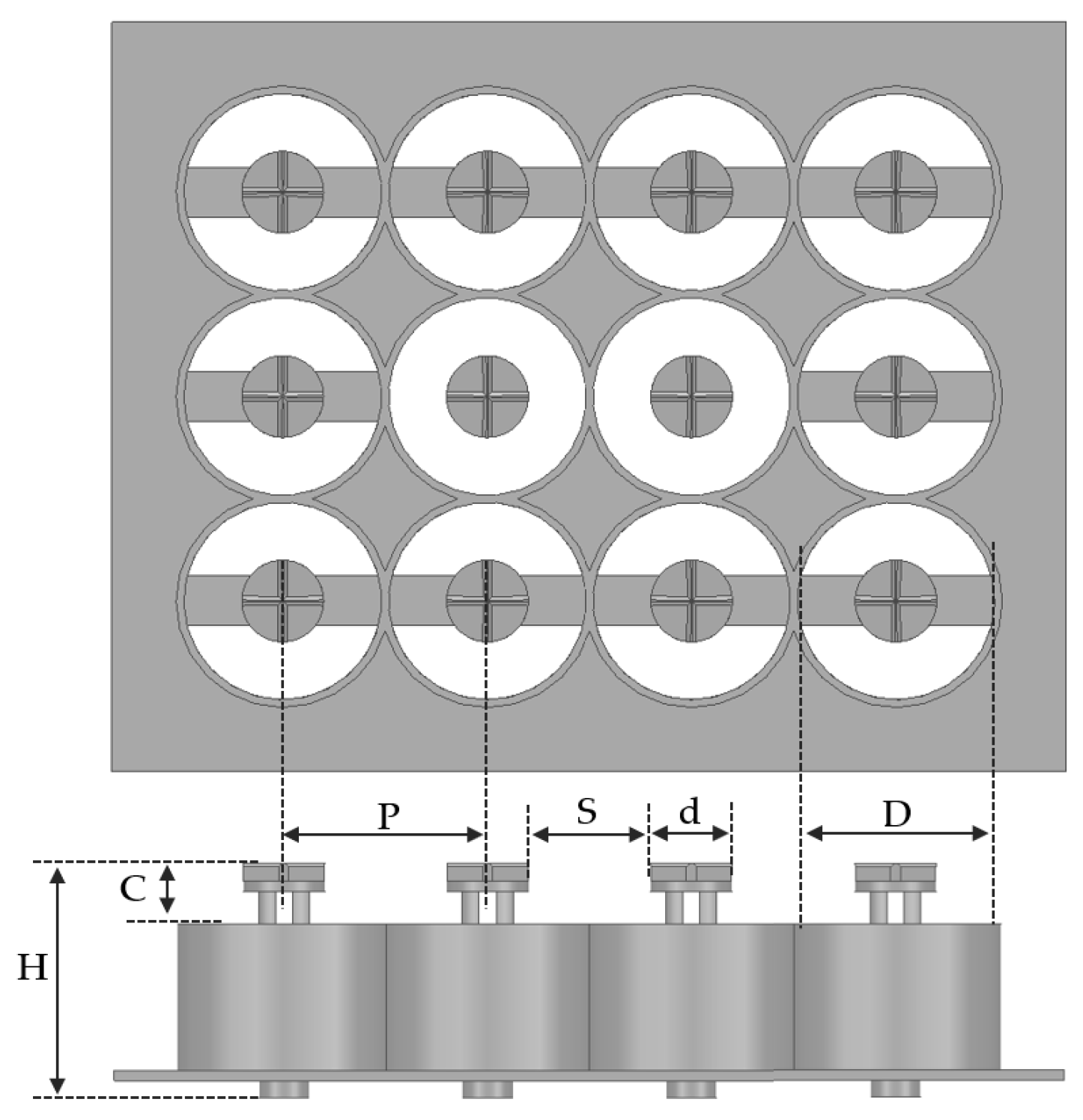
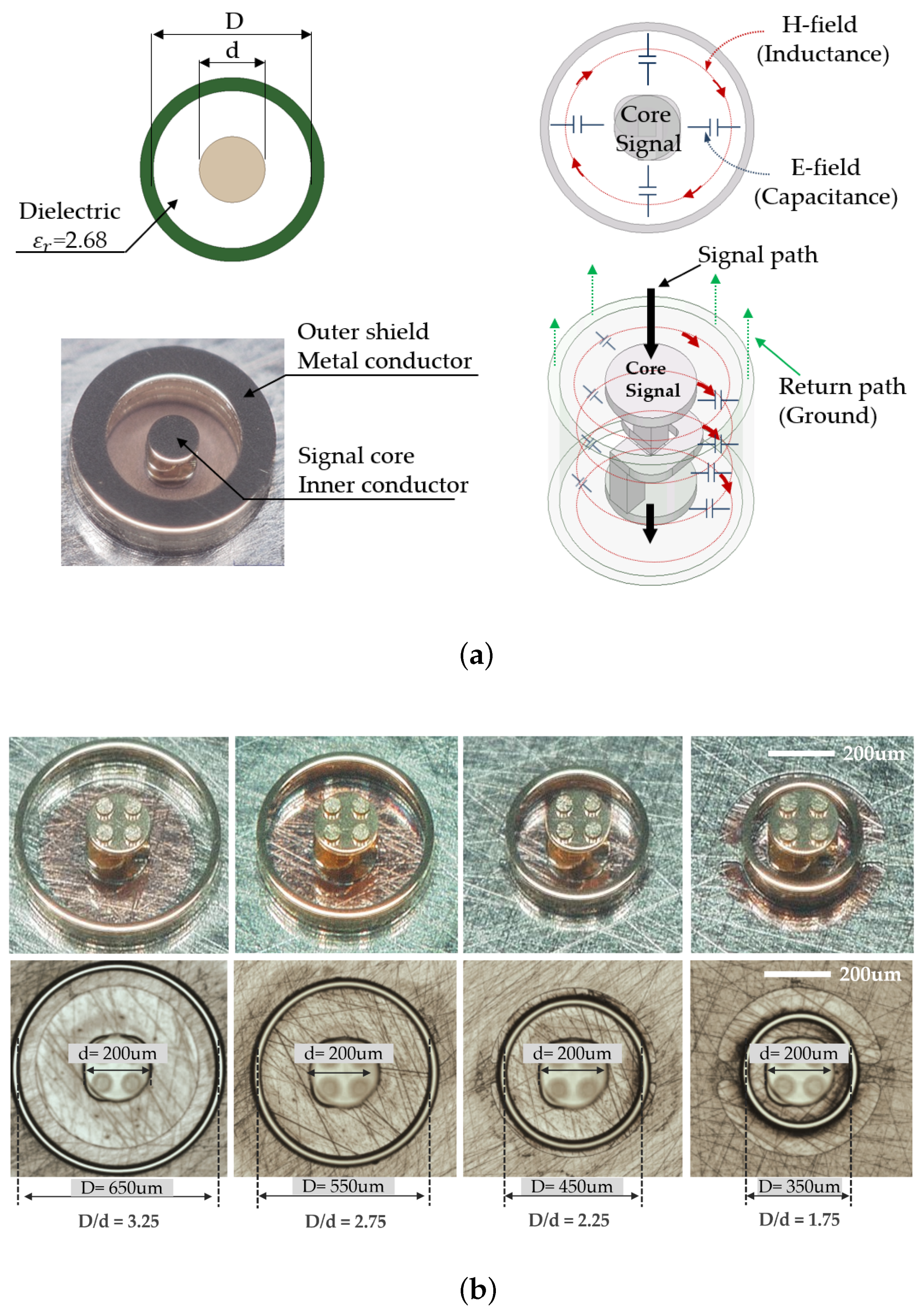
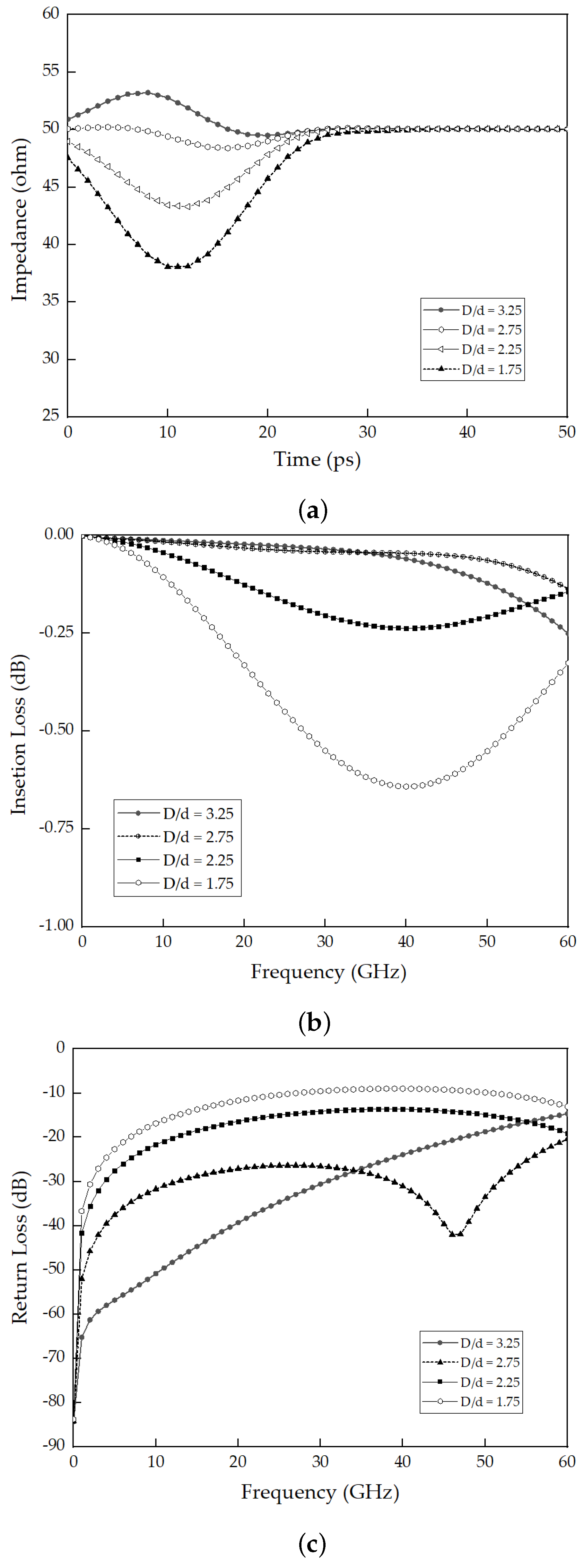
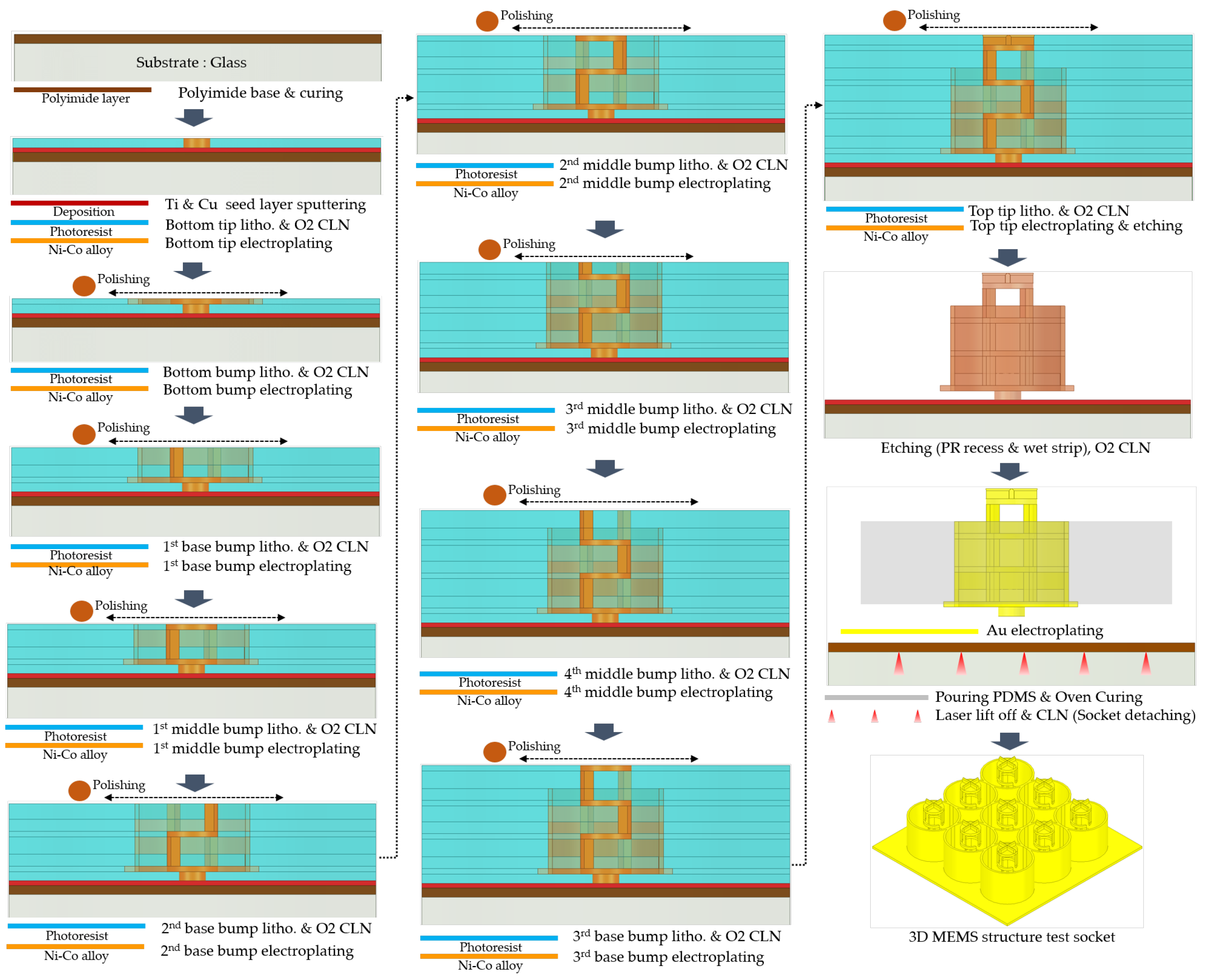

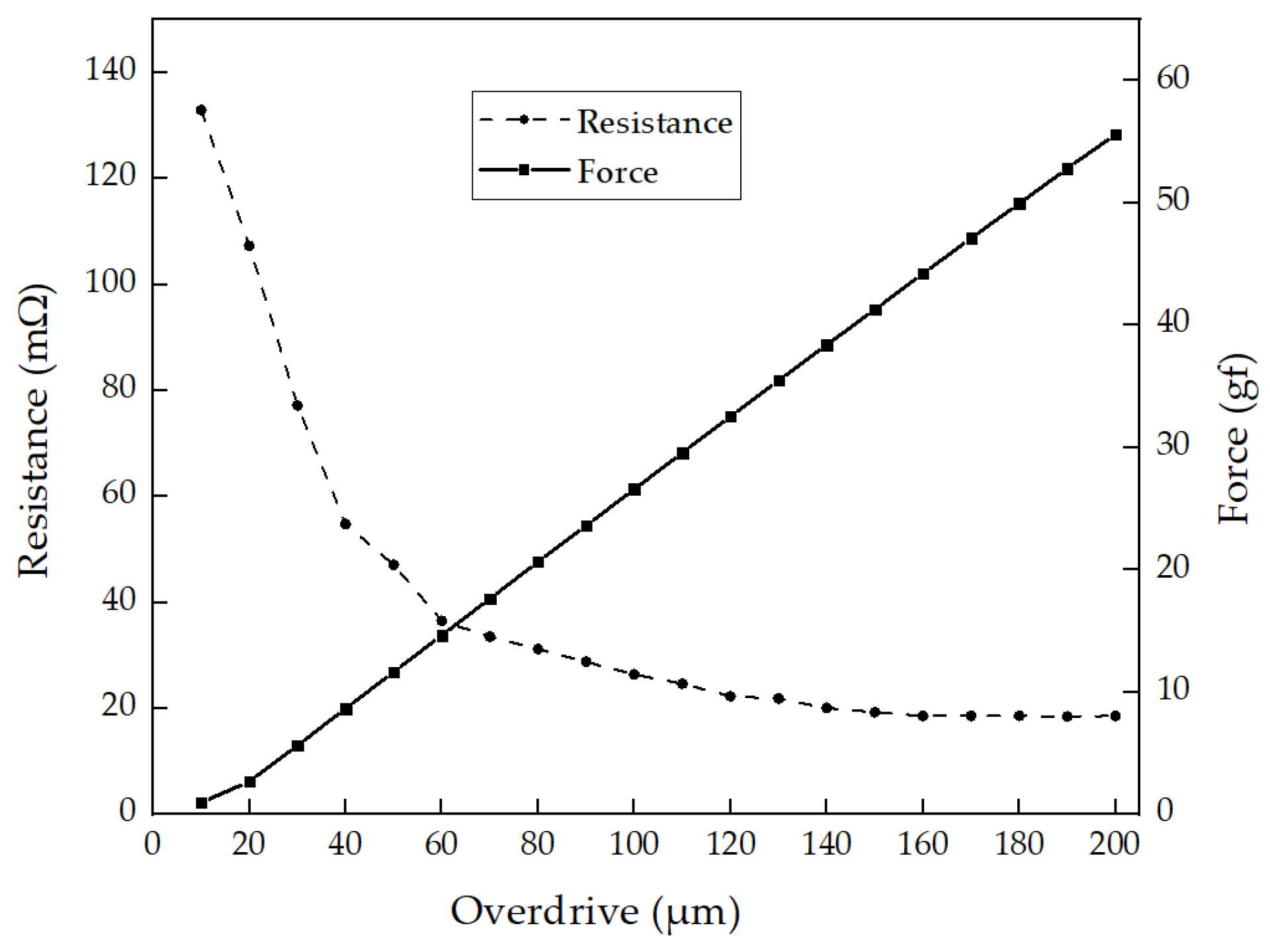

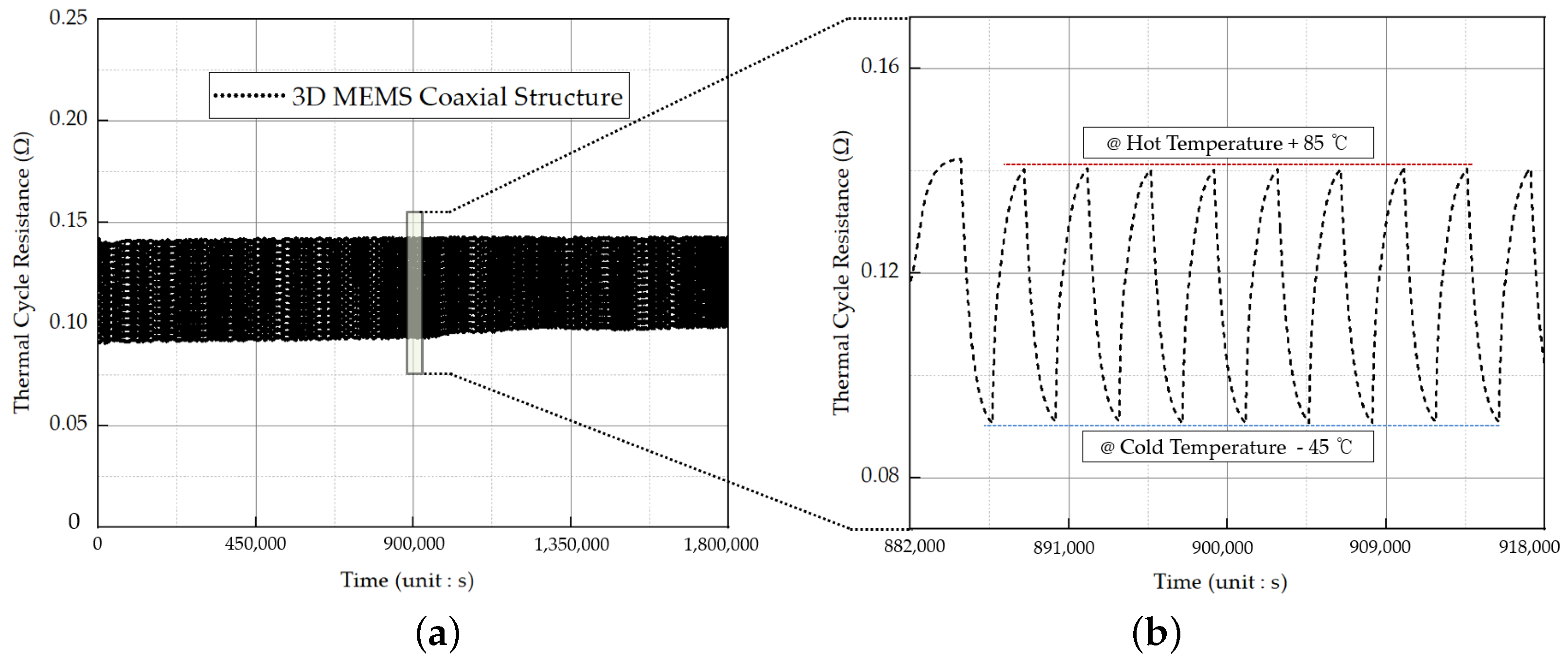

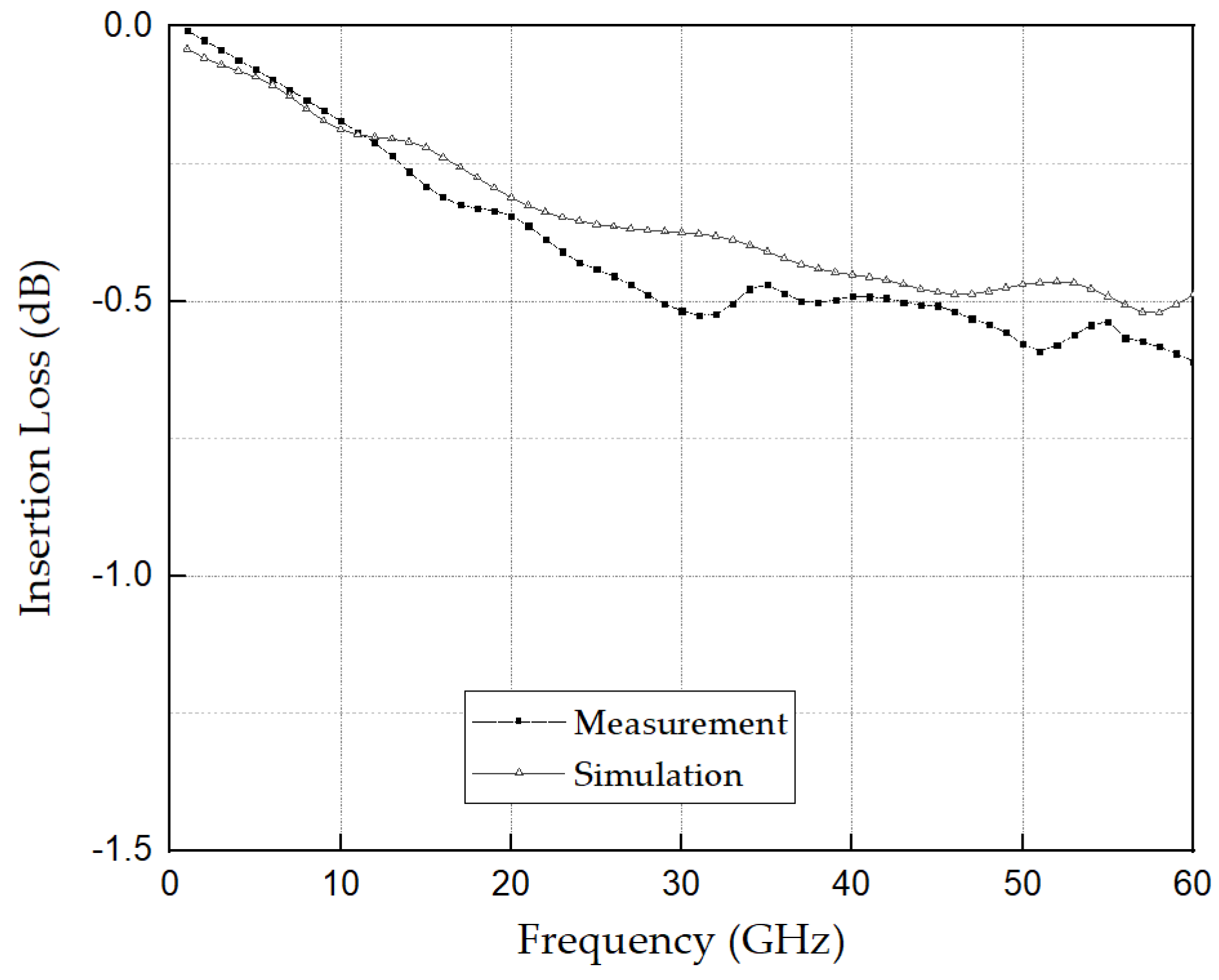
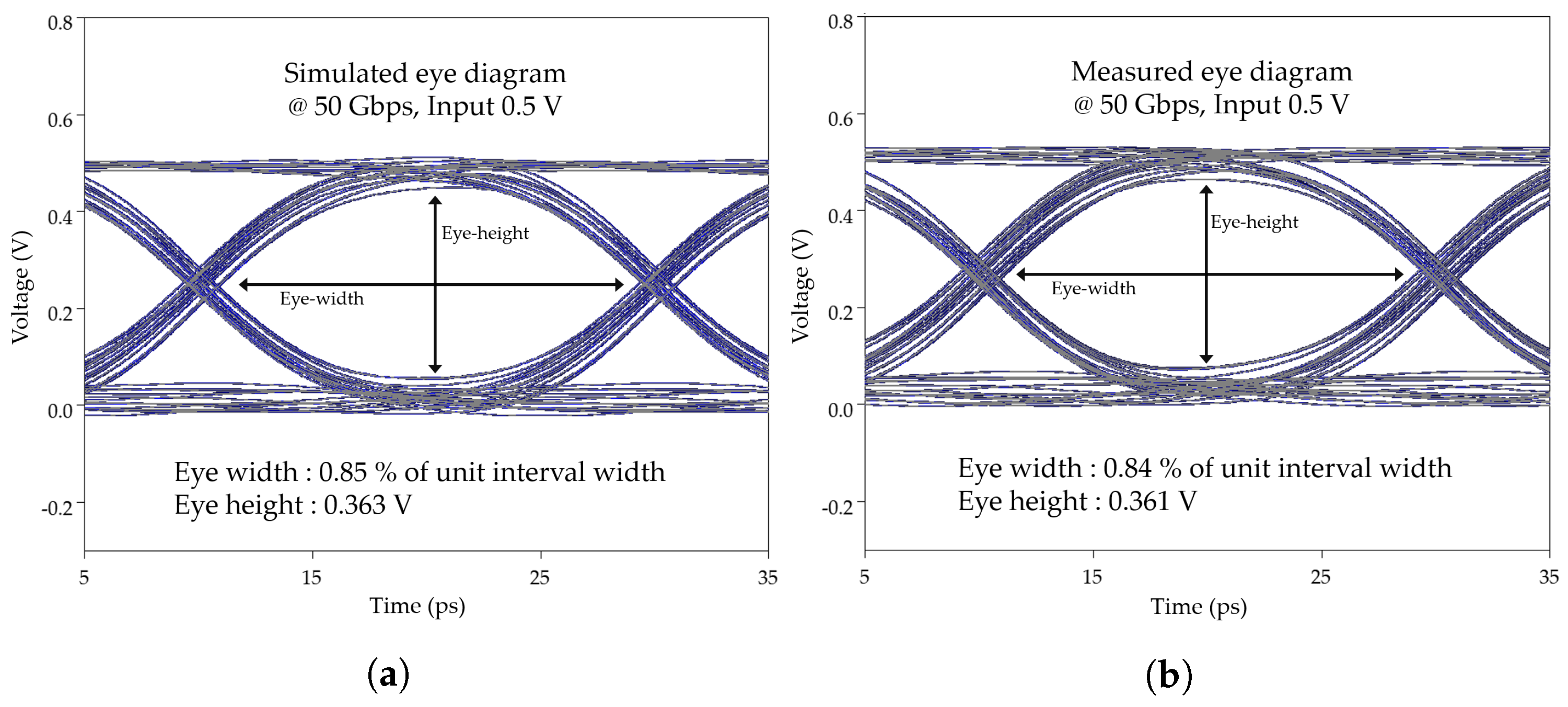
| 3D MEMS Coaxial Socket | Rubber Coaxial Socket | Spring Coaxial Socket | |
|---|---|---|---|
| · High-speed test | |||
| · Impedance controllable | |||
| · Fine pitch (MEMS lithography) | · Manufacturing price | ||
| Pros | · Position accuracy | · Low contact force (less ball damage) [8] | · Reliable contact resistance [7] |
| · Large number of pin counts | · Short length (low inductance) [10] | · Long height (long stroke) [5] | |
| · Stable contact resistance | · Manufacturing time | · sharpened contact tip [7] | |
| · Durability, longevity | |||
| Cons | · Fabrication difficulty | · Fine-pitch design | · Long length (high inductance) |
| · Manufacturing time | · Limited size of coaxial socket | · Machinability [6] | |
| · Short stroke | · Thermal durability, longevity [8] | · High price | |
| · Short stroke [9] |
| Symbol | Parameter | Unit | Value |
|---|---|---|---|
| C | Head height of the 3D MEMS structure | mm | 0.20 |
| S | Gap between two heads | mm | 0.39 |
| D | Inner diameter of the outer conductor | mm | 0.58 |
| d | Outer diameter of the inner conductor | mm | 0.21 |
| H | Total height | mm | 0.70 |
| P | Pad pitch | mm | 0.60 |
| Property | Unit | Value |
|---|---|---|
| Color | Colorless | |
| Mixing | 10:1 (Polymer) | |
| Viscosity (Base) | cP | 5100 |
| Viscosity (Mixed) | cP | 3500 |
| Thermal Conductivity | W/m K | 0.27 |
| Specific Gravity (Cured) | 1.03 | |
| Cure Time at 25 C | h | 48 |
| Heat Cure Time at 100 C | min | 35 |
| Heat Cure Time at 125 C | min | 25 |
| Heat Cure Time at 150 C | min | 10 |
| Durometer Shore | 43 | |
| Dielectric Strength | kV/mm | 19 |
| Volume Resistivity | cm | 2.9 × 1014 |
| Dielectric Constant at 100 Hz | 2.72 | |
| Dielectric Constant at 100 kHz | 2.68 | |
| Dissipation Factor at 100 Hz | 0.00257 | |
| Dissipation Factor at 100 kHz | 0.00133 | |
| Linear CTE (by DMA) | ppm/C | 340 |
| Tensile Strength | MPa | 6.7 |
| Useful Temperature Ranges | C | −45 to 200 |
| F | −49 to 392 |
Disclaimer/Publisher’s Note: The statements, opinions and data contained in all publications are solely those of the individual author(s) and contributor(s) and not of MDPI and/or the editor(s). MDPI and/or the editor(s) disclaim responsibility for any injury to people or property resulting from any ideas, methods, instructions or products referred to in the content. |
© 2023 by the authors. Licensee MDPI, Basel, Switzerland. This article is an open access article distributed under the terms and conditions of the Creative Commons Attribution (CC BY) license (https://creativecommons.org/licenses/by/4.0/).
Share and Cite
Kim, T.-K.; Yook, J.-G.; Kim, J.-Y.; Cho, Y.-H.; Lee, U.-H. Fabrication and Characterization of Three-Dimensional Microelectromechanical System Coaxial Socket Device for Semiconductor Package Testing. Sensors 2023, 23, 6350. https://doi.org/10.3390/s23146350
Kim T-K, Yook J-G, Kim J-Y, Cho Y-H, Lee U-H. Fabrication and Characterization of Three-Dimensional Microelectromechanical System Coaxial Socket Device for Semiconductor Package Testing. Sensors. 2023; 23(14):6350. https://doi.org/10.3390/s23146350
Chicago/Turabian StyleKim, Tae-Kyun, Jong-Gwan Yook, Joo-Yong Kim, Yong-Ho Cho, and Uh-Hyeon Lee. 2023. "Fabrication and Characterization of Three-Dimensional Microelectromechanical System Coaxial Socket Device for Semiconductor Package Testing" Sensors 23, no. 14: 6350. https://doi.org/10.3390/s23146350
APA StyleKim, T.-K., Yook, J.-G., Kim, J.-Y., Cho, Y.-H., & Lee, U.-H. (2023). Fabrication and Characterization of Three-Dimensional Microelectromechanical System Coaxial Socket Device for Semiconductor Package Testing. Sensors, 23(14), 6350. https://doi.org/10.3390/s23146350







